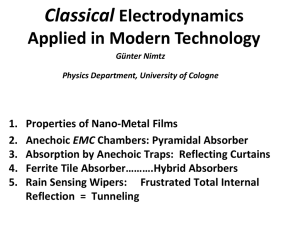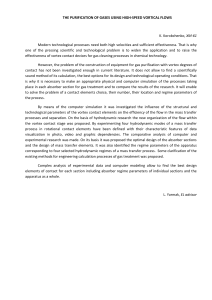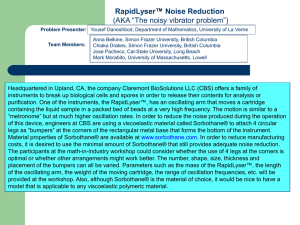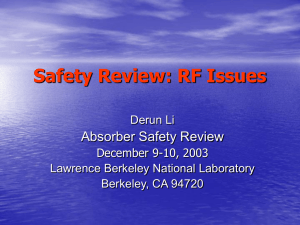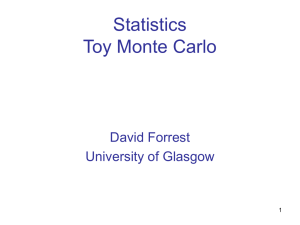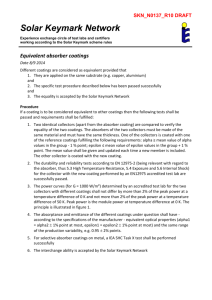EXPERIMENTAL OBSERVATIONS OF CENTRIFUGAL PENDULUM
advertisement
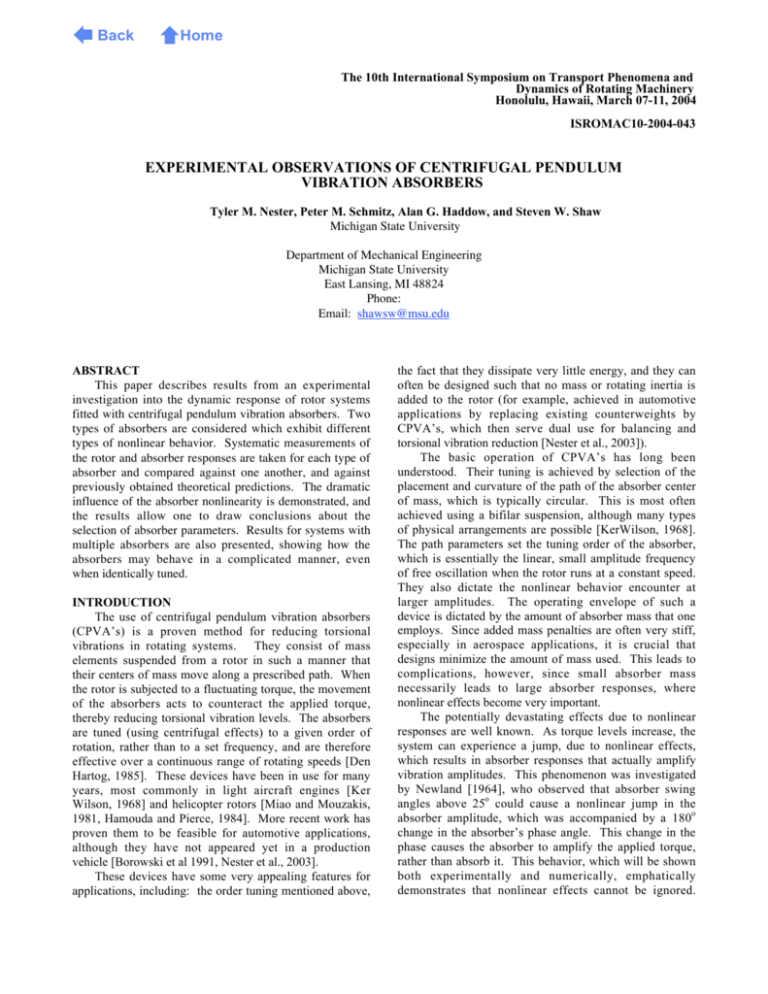
Back Home The 10th International Symposium on Transport Phenomena and Dynamics of Rotating Machinery Honolulu, Hawaii, March 07-11, 2004 ISROMAC10-2004-043 EXPERIMENTAL OBSERVATIONS OF CENTRIFUGAL PENDULUM VIBRATION ABSORBERS Tyler M. Nester, Peter M. Schmitz, Alan G. Haddow, and Steven W. Shaw Michigan State University Department of Mechanical Engineering Michigan State University East Lansing, MI 48824 Phone: Email: shawsw@msu.edu ABSTRACT This paper describes results from an experimental investigation into the dynamic response of rotor systems fitted with centrifugal pendulum vibration absorbers. Two types of absorbers are considered which exhibit different types of nonlinear behavior. Systematic measurements of the rotor and absorber responses are taken for each type of absorber and compared against one another, and against previously obtained theoretical predictions. The dramatic influence of the absorber nonlinearity is demonstrated, and the results allow one to draw conclusions about the selection of absorber parameters. Results for systems with multiple absorbers are also presented, showing how the absorbers may behave in a complicated manner, even when identically tuned. INTRODUCTION The use of centrifugal pendulum vibration absorbers (CPVA’s) is a proven method for reducing torsional vibrations in rotating systems. They consist of mass elements suspended from a rotor in such a manner that their centers of mass move along a prescribed path. When the rotor is subjected to a fluctuating torque, the movement of the absorbers acts to counteract the applied torque, thereby reducing torsional vibration levels. The absorbers are tuned (using centrifugal effects) to a given order of rotation, rather than to a set frequency, and are therefore effective over a continuous range of rotating speeds [Den Hartog, 1985]. These devices have been in use for many years, most commonly in light aircraft engines [Ker Wilson, 1968] and helicopter rotors [Miao and Mouzakis, 1981, Hamouda and Pierce, 1984]. More recent work has proven them to be feasible for automotive applications, although they have not appeared yet in a production vehicle [Borowski et al 1991, Nester et al., 2003]. These devices have some very appealing features for applications, including: the order tuning mentioned above, the fact that they dissipate very little energy, and they can often be designed such that no mass or rotating inertia is added to the rotor (for example, achieved in automotive applications by replacing existing counterweights by CPVA’s, which then serve dual use for balancing and torsional vibration reduction [Nester et al., 2003]). The basic operation of CPVA’s has long been understood. Their tuning is achieved by selection of the placement and curvature of the path of the absorber center of mass, which is typically circular. This is most often achieved using a bifilar suspension, although many types of physical arrangements are possible [KerWilson, 1968]. The path parameters set the tuning order of the absorber, which is essentially the linear, small amplitude frequency of free oscillation when the rotor runs at a constant speed. They also dictate the nonlinear behavior encounter at larger amplitudes. The operating envelope of such a device is dictated by the amount of absorber mass that one employs. Since added mass penalties are often very stiff, especially in aerospace applications, it is crucial that designs minimize the amount of mass used. This leads to complications, however, since small absorber mass necessarily leads to large absorber responses, where nonlinear effects become very important. The potentially devastating effects due to nonlinear responses are well known. As torque levels increase, the system can experience a jump, due to nonlinear effects, which results in absorber responses that actually amplify vibration amplitudes. This phenomenon was investigated by Newland [1964], who observed that absorber swing angles above 25o could cause a nonlinear jump in the absorber amplitude, which was accompanied by a 180o change in the absorber’s phase angle. This change in the phase causes the absorber to amplify the applied torque, rather than absorb it. This behavior, which will be shown both experimentally and numerically, emphatically demonstrates that nonlinear effects cannot be ignored. Newland [1964] also describes a systematic means of dealing with these effects, by intentionally detuning the absorbers at small amplitudes in such a manner that they come into proper tuning at moderate amplitudes. This works, but at the expense of absorber performance, as shown below. In a major development, Madden [1980] proposed the use of noncircular (specifically, cycloidal) paths that allow for small amplitude tuning while maintaining, at least approximately, the desired tuning over a large range of amplitudes, thereby avoiding the jump. Subsequent studies considered the effectiveness of absorbers constructed with a range of paths, which include the traditional circles, the cycloids proposed by Madden, as well as a class of epicycloids with special properties [Denman, 1992, Shaw et al., 1997, Chao et al., 1997]. In typical applications the total amount of absorber mass is divided up into a set of nominally identical absorbers that are arranged to satisfy balancing and space requirements. In such a case, the absorbers may not behave in a synchronous manner with equal amplitudes. In fact, analytical results have predicted that systems of nearly identical absorbers can undergo two basic types of instabilities. The first type is the jump described above, which maintains the absorbers in an equal amplitude motion. The other type is a symmetry breaking bifurcation that results in the absorbers oscillating at different amplitudes and/or phases [Chao et al., 1997]. The former instability (which occurs for circular path absorbers, but not cycloids or epicycloids) results in a catastrophic failure of the absorber system, while the latter instability (which can occur for all path types, depending on tuning) is more benign, although it does limit the torque range over which the absorbers operate effectively [Alsuwaiyan and Shaw, 2002]. Similarly, when the absorbers have small differences among them, the response can become localized, wherein a small subset of absorbers (maybe only one) does most of the work of canceling vibrations and therefore oscillates at a much larger amplitude than that predicted by assuming identical absorbers [Alsuwaiyan and Shaw, 1999, 2003]. The method to avoid this localization and the instabilities is to intentionally overtune all the absorbers, which reduces absorber effectiveness [Alsuwaiyan and Shaw, 2002, 2003]. Although much work has been done in this area, past experimental work has been limited primarily to specific implementations. Various types of engines, helicopter rotors, etc., have been built and tested, but previous experimental efforts have been limited to verifying that CPVA’s lowered the vibration levels in the system of interest. In contrast, the present work describes systematic, controlled experiments that monitored both the response of the absorbers and the rotor for a variety of operating conditions. In this work we report and compare results from recent experimental studies that consider two absorber systems, one with circular path compound pendulums each suspended from a single point, and the other with epicycloidal paths suspended with a bifilar arrangement. The paper is outlined as follows. We begin with a brief overview of the theoretical background, followed by a short description of the experimental apparatus used. The main results are then shown in the form of response diagrams that depict experimental data compared against theoretical predictions. The paper is closed with a discussion of the differences between the two different absorber systems and some conclusions. THEORETICAL BACKGROUND In this section we first outline the basic tuning results for the absorbers, and the nonlinear nature of the two paths to be considered is then described. A brief summary of the analysis is presented, along with some typical theoretical response curves. These results are used as background and to compare with the experimental results, which form the main part of the paper. An idealized representation of a rotor fitted with four absorbers is shown in Figure 1. For bifilar suspensions, such as the one shown in Figure 3 below, the absorbers can be modeled as point masses riding along paths on the rotor (in this case their rotational inertias simply add to the rotor inertia), whereas for single point suspensions the rotational inertia of the absorbers must be taken into account for the tuning. Figure 1: Schematic of a rotor fitted with four general path CPVA’s. The absorber paths can be taken to be quite general, but two features are of importance: the linear tuning and the nonlinearity of the path. According to small amplitude vibration theory, the linear tuning order of the CPVA’s shown in Figure 1 is given by: ~ n= rR r + r2 ( 2 ) (1) where R and r are the distances shown in Figure 1 and r is the radius of gyration associated with the non-zero moment of inertia of the absorber about its center of mass. Note that r=0 for the bifilar suspension, since the absorber 2 rotates with the main rotor. By adjusting the radius of the absorber path and the absorber’s center of rotation, it is possible to tune the CPVA to absorb any desired order (within hardware constraints). For a constant rotor speed, W, the linearized natural frequency of the tuned absorber in Figure 1 is given by The nonlinearity in the path can be described mathematically [Denman, 1992, Alsuwaiyan and Shaw, 2002], but can also be conveniently depicted graphically, as shown in Figure 2. The circular path is easily realized in experiments, in the present case by using the “T” shaped pendulums shown in Figure 3. The epicycloidal path is achieved by having the absorber mass connected to two straps that wrap along cheeks shaped so that the absorber mass follows the desired curve, as shown in Figure 2 and 3 [Schmitz, 2003]. From Figure 2 it is seen that the differences between circles and epicycloids that are tuned to the same linear order are nearly identical up to moderate amplitudes. However, as demonstrated below, this small difference has a large effect on the qualitative behavior of the system response at moderate amplitudes. w 0 = n~W (which reduces to W R / r , the classical result, for r=0). For a system with an applied torque of order n, for example, of the form T0 sin( nWq ) , where q is the rotor angle, a CPVA is referred to as being overtuned (undertuned) for n~ > (<)n , respectively. Absorbers are generally overtuned, in order to avoid localization and nonlinear jumps [Alsuwaiyan and Shaw, 2002, 2003]. CENTER Of ROTATION R c m i CHEEK r CG PATH Figure 2: Left: Schematic showing circular and epicycloidal path geometries tuned to the same linear order. Right: schematic showing how the epicycloidal path is realized using straps wrapping on cheeks. Figure 3: Schematic diagrams: Left: rotor with two compound pendulum CPVA’s attached. Right: Close up of the bifilar absorber configuration with straps and cheeks. The analysis for determining the system response can be found in previous work by the authors [Alsuwaiyan and Shaw, 2002, Nester 2002]. The results are obtained by perturbation methods that are based on a particular scaling of the system parameters. This scaling takes advantage of realistic ranges of physical parameters and renders the following small quantities: the ratio of absorber inertia to rotor inertia, the absorber damping, the applied torque, and the nonlinearities in the response. It should be noted that the scaling for the case of absorbers that use a single point support requires some modification [Nester 2002], which results in equations of motion that are equivalent to those which use a bifilar support [Schmitz 2003]. The basic model consists of N identical (or nearly identical) absorbers attached to a rigid rotor that is subjected to an applied torque of order n. In order to analyze the equations of motion using perturbation techniques, the equations are formulated for a general path 3 steady state responses are shown for both the absorber motion and the rotor response. The measure used to represent the rotor torsional vibration response is the order n harmonic amplitude of its angular acceleration, which represents its fluctuating component. The first type of response curve, which is more useful from a parameter selection/design point of view, is for the case in which the torque amplitude and absorber order are fixed and the order of the applied torque is varied. This allows one to consider how the absorber should be tuned relative to the torque to achieve good performance. Figure 4 shows samples of these curves, indicating the basic differences in the responses for absorbers with circular and epicycloidal paths as the order of the applied torque is varied. (Note that these theoretical results are equivalent to frequency response curves.) Response curves for three levels of torque are shown. On the left are the results from circles, which show how the detuning of the absorber at moderate amplitudes shifts the minimum point of the rotor acceleration and bends the absorber resonance curve (due to the softening nonlinearity of the pendulum). Here the effects of intentionally overtuning the absorber are clear, specifically, by designing the absorber so that the response is to the left of the low torque amplitude minimum, one can maintain a relatively small vibration level as the torque is increased. These nonlinear features are notably absent from the epicycloidal case, shown on the right, even out to large amplitudes. This is due to the fact that the epicycloid is precisely the curve that is neither hardening nor softening at linear order [Denman, 1992, Alsuwaiyan and Shaw, 2002, Chao et al., 1997]. The other type of response curve considers a fixed order of the applied torque and a fixed tuning of the absorber and an increasing amplitude of the fluctuating torque. These curves show how an absorber responds in actual implementations, since the tuning is fixed by hardware, while the applied torques vary depending on operating conditions. Figure 5 shows theoretical response curves for the rotor vibration levels (on the left) and the absorber amplitudes (on the right) for circular path absorbers, for various levels of absorber tuning. The primary features of these curves can be described by considering a situation in which the amplitude of the fluctuating torque is slowly increased from zero up to some level and then decreased back to zero. It is seen that the absorber amplitudes increase up to a point at which a jump occurs, resulting in the response being on the upper part of the curve, where the absorber amplifies the torsional vibration. Further increases simply make this situation worse. The attendant rotor vibrations, measured by the amplitude of the rotor’s angular acceleration, also increases as the torque increases, almost up to the jump point, although for some levels of mistuning it turns down slightly just before the jump. Note that the absorberslocked reference line clearly shows the vibration attenuation and amplification for responses before and after the jump, respectively. absorber and then non-dimensionalized. The resulting equations are then transformed such that the rotor angle serves as the independent variable, instead of time [Alsuwaiyan and Shaw, 2002]. Using this change of variables and assuming that the N absorbers, their paths, and their responses are identical, Alsuwaiyan and Shaw [2002] showed that the equations of motion for the system are given by: È ~ ˘ 1 dx (s )v = - m a s' vs' '+ Í s '+ g (s )˙ v'Î ˚ 2 ds ~ È dx 2 ˘ Í ds s ' v + x(s )vv'+ g (s )s ' vv'˙ ˙ + vv' = eÍ ~ Í ~ ˙ dg 2 2 2 (s )s v ˙ Í+ g (s )s ' ' v + ds Î ˚ (2) (3) ~ em a g (s )s ' v - m 0 v + G0 + Gq (q ) where s is the normalized displacement along the absorbers’ arc length (see Figure 1), v is the rotor’s angular velocity normalized by the rotor’s mean rate of rotation, and primes denote differentiation with respect to q . The absorbers each have mass m and their paths are described in Equations (2) and (3) by the function x(s), which represents the square of the distance from the center of rotation to the absorber’s center of mass as it moves along ~ the path. The function g (s ) is a path function related to x ( s ) arising from the Lagrangian derivation of the equations of motion. The nondimensional damping terms in Equations (2) and (3) are given by m a for the absorbers and m 0 for the rotor. The parameter e is a measure of the ratio of the absorber inertia to the rotor inertia. For point mass absorbers and bifilar absorbers, e =mR02/J, where J is the rotor moment of inertia and R 0=R+r. When the absorbers cannot be modeled as point masses, such as for the “T” absorbers, additional scaling must be performed so that the equations of motion match the form of Equations (2) and (3) [Nester 2002]. The non-dimensional torque applied to rotor consists of a constant term given by G 0 and a fluctuating term given by G q (q ) (which are the actual torques normalized by the kinetic energy of the rotor). Extensive analytical results have been obtained using perturbation techniques for Equations (2) and (3) [Alsuwaiyan and Shaw, 2002, Chao et al., 1997]. The analysis first uncouples the rotor dynamics to leading order using the small inertia ratio. Averaging is then employed by assuming that the absorber response is harmonic with a slowly varying amplitude and phase. This leads to slow time equations governing the amplitude and phase, which are examined for steady state responses and their stability. Here we present results from these analyses in the form of response curves, in order to compare experimental results to the analytical predictions. Response curves are generated for two types of parameter sweeps. In these, the amplitudes of the order n harmonic components of the 4 The effects of mistuning the absorber are clear here. The jump point is delayed by increasing the mistuning, although the absorber performance is degraded over the operating range. In fact, one can see that for very low torques the perfectly tuned absorber works very well, but that the jump occurs at small torque levels. Thus, it is seen that there exists a compromise between absorber performance and operating range. Typical designs that use circular path absorbers use intentional detuning of about 5%. Similar curves for epicycloidal path absorbers are shown below along with experimental data. In addition to response curves predicted by theoretical methods, simulations have also been carried out on the fully nonlinear equations of motion. Therefore, in the results shown below, experimental data are compared against both theoretical curves and simulation results. Figure 4: Effect of varying torque order n on the angular acceleration (top) and the absorber motion (bottom) for circular paths (left) and epicycloidal paths (right), near the tuning order. Three increasing torque levels shown. Figure 5: Theoretical response curves versus fluctuating torque level for circular path absorbers, for various levels of mistuning. On the left is the rotor angular acceleration while on the right is the corresponding absorber amplitude. 5 Steady-state signals for the torque and system responses are stored and processed using FFT software and a FFT analyzer, which distills the amplitudes of the harmonic components at the order of interest. Physical parameters were obtained via a series of measurements. Some of the important parameters for the two absorber systems are listed in Table 1. Results were obtained for each of the absorber systems shown in Figure 3. For the circular path absorber, data was taken for one, two and four absorber configurations, while one and two absorber configurations were used for the epicycloidal path absorbers. EXPERIMENTAL SETUP The experimental apparatus, described in detail in Nester [2002], consists of a pulse-width modulated electric motor that drives a rotor to which up to four absorbers can be attached; see Figure 6. The motor is controlled such that the rotor maintains a constant average speed, upon which is superimposed a fluctuating torque. This torque is generated using the angular position of the motor, and can therefore be adjusted to any desired order – that is, the order is not linked to the mean rotation rate. This allows one to carry out order sweeps, something not possible when the torques arise from the inertial effects of attached components, gas pressure loading, etc. Absorber measurements are taken by optical encoders on each absorber and fed out through a slip ring. Rotor measurements are also taken by an encoder. The applied torque is measured by monitoring the armature current in the motor, which was calibrated using a torque meter. All data is fed into a computer for storage and presentation. Circular Path Epicycloidal Path Damping Ratio 0.00241 0.00344 Absorber Order 1.31 1.465 Inertia Ratio 0.052 0.075 Table 1: Parameter values for single absorber case. Figure 6: A schematic diagram of the experimental apparatus and a photo of the actual setup. correspond to vibration reduction due to the absorber dynamics, while those above it represent vibration amplification due to the absorber. We begin with results for the circular path case, then turn to the epicycloidal path case, and finally provide a general comparison. Figure 7 shows a set of sample experimental results, compared against theoretical curves and data obtained from simulations of the full equations of motion. The details of the experimentally determined system parameters can be found in Nester [2002]. Excellent agreement is found between the simulations and the experiments, and there is very good agreement between these data and the theoretical predictions. Note that the theory predicts the jump point to be higher than is observed; this is due, at least in part, to the fact that the response is highly sensitive near the jump point and the upper branch has a larger basin of attraction near this instability. Also, the theory is less accurate on the upper response branch, which stems from the fact that the EXPERIMENTAL RESULTS FOR A SINGLE ABSORBER We present and contrast results obtained from experiments for rotors with circular and epicycloidal path absorbers. In each case, the system with a single absorber is considered. Results are presented in the form of response amplitudes verses the amplitude of the fluctuating torque, where amplitudes are taken to be the magnitude of the Fourier component at the order being considered. Theoretical response curves are shown for the absorber amplitudes (on the left) and the rotor vibration levels (on the right), obtained using perturbation techniques. Solid lines represent stable responses while dashed lines represent unstable responses. Note that the reference straight lines on the rotor vibration response plots correspond to the case in which the absorbers are locked at their equilibria; this is used as a reference line on which the absorbers simply add inertia to the system, serving as simple flywheels. So, responses below this line 6 approximations are based on perturbation expansions that become less accurate at larger amplitudes. Overall, the theory does an excellent job of predicting the gross features of the response, the vibration amplitudes, and the trends that occur as system parameters are varied. Figure 8 shows similar results for the epicycloidal path absorbers with bifilar suspension, with experimental data and theoretical curves [Schmitz, 2003] shown on one set of plots for several levels of mistuning (simulation data are not shown here, but they match the experiments quite well). Note the excellent agreement between theory and experiments, for a range of absorber tuning values. The key feature of these results are that the jump does not occur and that one can therefore use the small amplitude tuning of the absorbers and still avoid the jump. However, it should be noted that the experimental data extends out to higher torque levels for absorbers that are more mistuned; this is due to the fact that the absorber amplitude grows less rapidly in these cases, and therefore the absorber amplitude limitations imposed by hardware constraints are encountered at higher torques. Figure 7: Sample results for the circular path system response, amplitude versus torque level. On the left is the rotor angular acceleration while on the right is the corresponding absorber amplitude. Figure 8. Theoretical and experimental results for the epicycloidal path system response, amplitude versus torque level. On the left is the rotor angular acceleration while on the right is the corresponding absorber amplitude. EXPERIMENTAL RESULTS FOR MULTIPLE ABSORBERS Figures 9 and 10 show the absorber amplitudes and rotor vibration amplitude versus non-dimensional torque level for the case when four absorbers are active. 7 Figure 9: Absorber amplitudes versus fluctuating torque amplitude for order 1.2987 torques. Figure 10: Experimental and theoretical rotor angular acceleration versus torque amplitude for order 1.2987 torques. In Figure 9, it is observed that initially only two absorbers are active, and that as the torque level is increased the other two absorbers became active one at a time, until all four are active and acting in unison. This trend was typical of the experimental results obtained for four circular path absorbers. This behavior, while intriguing, does not agree with the theoretical predictions [Alsuwaiyan and Shaw, 2002], which indicate that the absorbers will move in unison at low torque levels and that their amplitudes would grow as the applied torque level was increased, until an instability is reached. The outcome of the instability is a nonunison response, many types of which are possible. In addition to the experimental absorber amplitudes, analytical predictions [Alsuwaiyan and Shaw, 2002] are shown for the cases when two, three, and four absorbers are active (obtained by assuming that the inactive absorbers are locked). These curves are shown for reference, and it is seen that when only a subset of absorbers are active, the responses follow these predictions quite well. The corresponding angular acceleration for the absorber data shown in Figure 9 is shown in Figure 10. This data shows that the experimental angular acceleration follows the theoretical prediction for the case when four absorbers are moving in unison reasonably well. The scallops in the experimental angular acceleration at low torque levels correspond with the activation of additional absorbers as the angular acceleration approaches the theoretical curve. This behavior is currently not well understood and is being investigated analytically. path types, the lack of a jump in the response of the epicycloidal path absorber makes it more attractive, since jumps lead to very undesirable system responses. The data also confirm the utility of the perturbation analysis, which accurately predicts the system response. Such results allow designers of absorber systems to make intelligent estimates for the selection of absorber parameters. The experimental results for the multi-absorber case are not well understood and are the subject of current analysis. CONCLUSIONS The experimental data presented clearly show that advantages of using epicycloidal path absorbers over the commonly used circular paths. While one faces the tradeoff between performance and operating range for both V. J. Borowski, H. H. Denman, D. L. Cronin, S. W. Shaw, J. P. Hanisko, L. T. Brooks, D. A. Milulec, W. B. Crum, and M. P. Anderson. Reducing vibration of reciprocating engines with crankshaft pendulum vibration absorbers. 1991. SAE Technical Paper Series 911876. ACKNOWLEDGEMENTS This work was supported by the National Science Foundation under grant CMS 0084947. REFERENCES A. S. Alsuwaiyan and S. W. Shaw. Localization of Free Vibration Modes in Systems of Nearly Identical Vibration Absorbers. Journal of Sound and Vibration, 228(3):703711, 1999. A. S. Alsuwaiyan and S. W. Shaw. Performance and Dynamic Stability of General-Path Centrifugal Pendulum Vibration Absorbers. Journal of Sound and Vibration, 252(5):791-815, 2002. A. S. Alsuwaiyan and S.W. Shaw. Steady-State Responses of Systems of Nearly-Identical Torsional Vibration Absorbers. Journal of Vibration and Acoustics 125:80-87, 2003. 8 Back Home C.P. Chao, S.W. Shaw and C.T. Lee. Non-Unison Dynamics of Multiple Centrifugal Pendulum Vibration Absorbers. Journal of Sound and Vibration 204:769-794, 1997. W. Miao and T. Mouzakis. Nonlinear characteristics of the rotor bifilar absorber. 3 7th American Helicopter Society Forum, 1981. T. M. Nester. Experimental Investigation of Circular Path Centrifugal Pendulum Vibration Absorbers. M.S. Thesis, Michigan State University, 2002. H. H. Denman. Tautochronic bifilar pendulum torsion absorbers for reciprocating engines. Journal of Sound and Vibration, 159:251-277, 1992. T. M. Nester, A.G. Haddow, S.W. Shaw, J. E. Brevick, and V. J. Borowski. Vibration Reduction in a Variable Displacement Engine Using Pendulum Absorbers. The Society of Automotive Engineers, 2003. SAE Noise and Vibration Conference and Exposition. A. G. Haddow and S. W. Shaw. An experimental study of torsional vibration absorbers. Proceedings of Design Engineering Technical Conference 2001, Pittsburgh, PA, September 9-12. M. H. Hamouda and G.A. Pierce. Helicopter vibration suppression using simple pendulum absorbers on the rotor blade. Journal of American Helicopter Society, 29(3): 1929, July 1984. P. M. Schmitz. Experimental Investigation Into Epicycloidal Centrifugal Pendulum Vibration Absorbers. M.S. Thesis, Michigan State University, 2003. S. W. Shaw, V. K. Garg, and C-P. Chao. Attenuation of engine torsional vibrations using tuned pendulum absorbers. Volume 2, pages 713-722. The Society of Automotive Engineers, 1997. SAE Noise and Vibration Conference and Exposition. W. Ker Wilson. Practical Solution of Torsional Vibration Problems, chapter XXX. Volume IV, Chapman and Hall Ltd, London, 3rd edition, 1968. J. F. Madden. Constant frequency bifilar vibration absorber. United States Patent No. 4218187, 1980. 9
